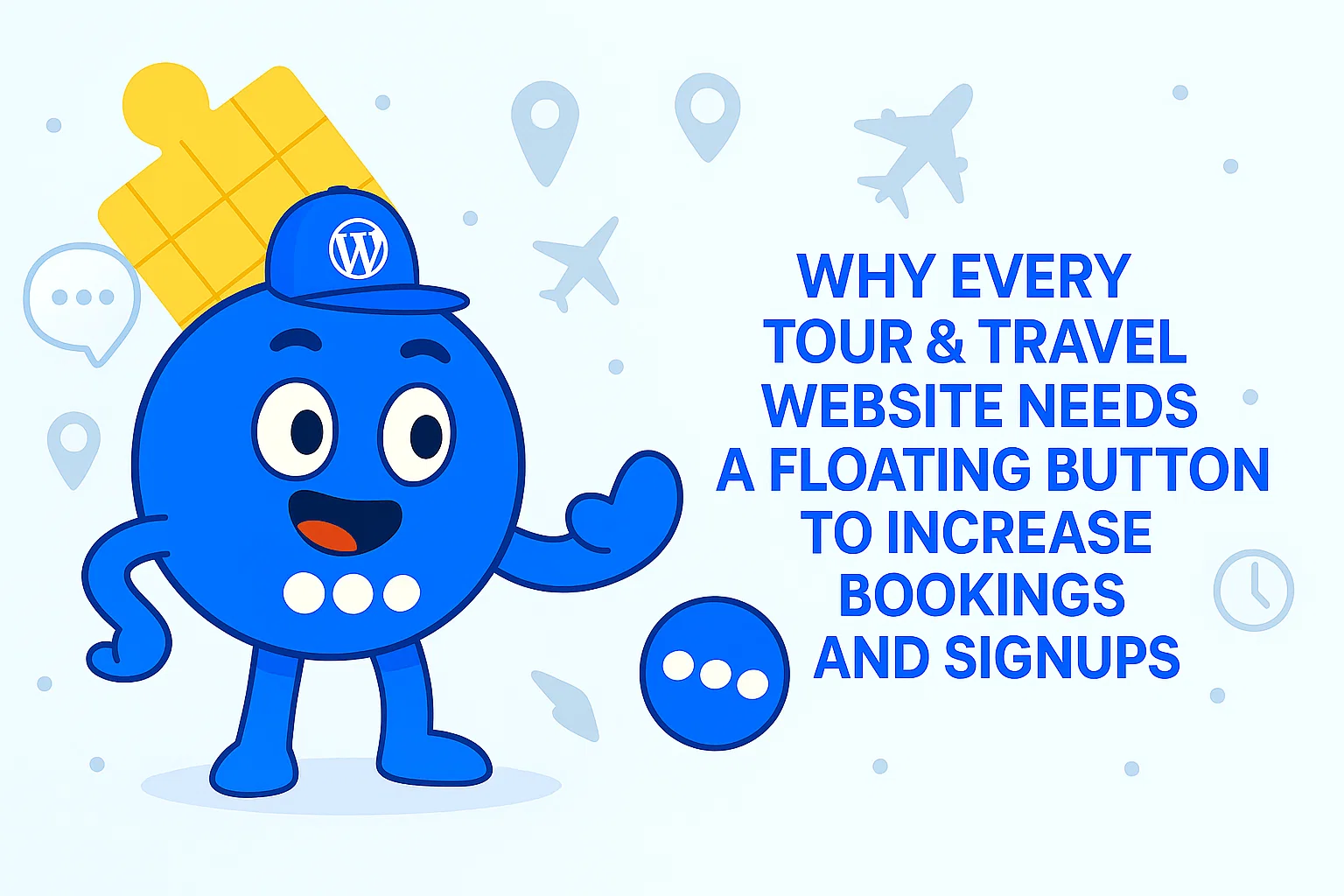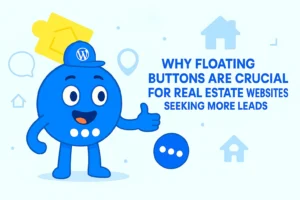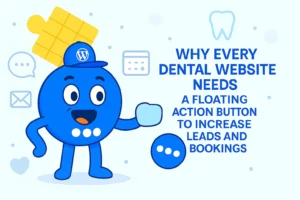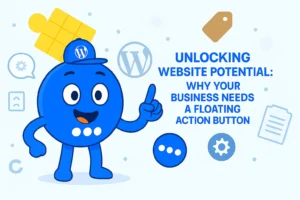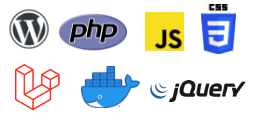Why Every Tour & Travel Website Needs a Floating Button to Increase Bookings and Signups
In today’s digital world, a website’s ability to engage visitors is more important than ever. Especially for businesses in the travel and tourism industry, a well-designed, user-friendly website can make all the difference between a casual visitor and a converted customer. One simple yet powerful tool that can drastically improve user engagement is the floating action button (FAB).
FABs are small, clickable buttons that stay visible on the screen as visitors scroll through your site. Whether you’re encouraging users to book a tour, subscribe to your newsletter, or simply return to the top of the page, floating buttons make it easier for users to take action with just one click. For travel websites, they can serve as a helpful assistant that boosts interaction, making it simple for users to engage with your business in a way that’s intuitive and seamless.
What is a Floating Action Button (FAB)?

A Floating Action Button (FAB) is a modern user interface element designed to remain visible on a webpage while users scroll. Typically, it is positioned in one of the corners of the screen, making it always accessible to the visitor without requiring them to navigate back to the top of the page or search through menus. It’s called a “floating” button because, as the user scrolls, the button stays in place, offering a non-intrusive way to guide them toward important actions, such as signing up for a service, making a purchase, or getting in touch with your business.
In its most basic form, a FAB is a circular button that stands out from the rest of the page, often featuring an icon or text that signifies its purpose. For instance, a travel website might have a floating button with an icon like a plane or a suitcase to encourage users to start their booking process. The button could also display text like “Book Now,” “Get a Quote,” or “Contact Us,” guiding users to take specific actions with a single click.
Floating action buttons are particularly effective for mobile websites. On smaller screens, where space is limited, a floating button provides an easily accessible way for users to engage with the website without being forced to scroll through lengthy pages. It allows users to quickly access crucial elements without interrupting their browsing experience.
One of the primary advantages of a floating action button is its ability to stay consistent across different screen sizes and types of devices, making it an essential tool for enhancing the user experience. The button remains in the user’s line of sight, offering quick access to actions that are critical for the success of a website—whether that’s making a purchase, subscribing to a newsletter, or simply contacting the business for more information.
In the context of travel websites, FABs are especially valuable. When visitors are looking for quick information or to take action—like booking a trip, contacting an agent, or subscribing to updates on new destinations—a floating button keeps these options front and center without requiring visitors to dive through multiple pages or complicated navigation systems. This ease of access encourages interaction, which can ultimately lead to higher conversion rates and a more satisfied user base.
The Benefits of Floating Action Buttons for Travel Websites
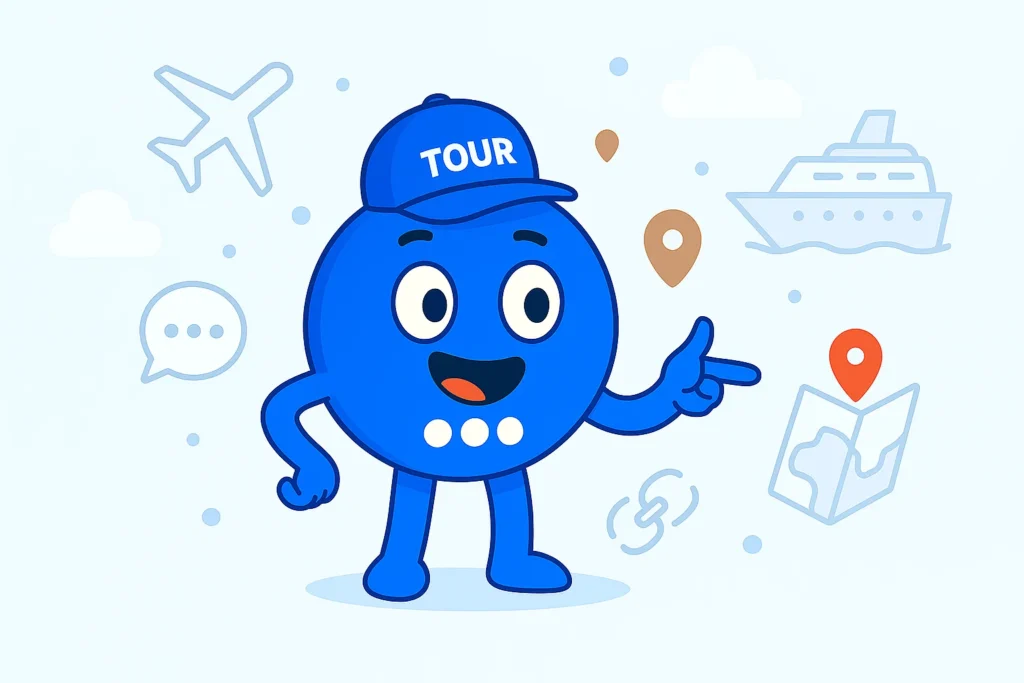
Floating Action Buttons (FABs) bring several advantages to travel websites, particularly in terms of improving user experience, driving engagement, and boosting conversion rates. Here’s a deeper look into the benefits of using floating buttons on a tour and travel website:
1. Improved User Experience and Navigation
One of the most significant advantages of FABs is the improvement in user experience. Travel websites often contain a lot of information—destinations, itineraries, pricing details, and booking forms—making navigation challenging. Visitors might get lost or frustrated trying to find specific content, which can increase bounce rates.
FABs help streamline this experience by providing an easily accessible shortcut to key actions. Instead of requiring users to scroll through the entire page or search through various menus, a floating button ensures that critical options like booking, contacting the company, or browsing special deals are always within reach. This constant visibility allows users to interact with the website without feeling overwhelmed, improving the overall experience and leading to increased satisfaction.
2. Increased Conversion Rates (Bookings, Sign-ups, Inquiries)
Floating buttons play a crucial role in increasing conversion rates on travel websites. Conversion is the ultimate goal—whether it’s turning a visitor into a booker, a newsletter subscriber, or someone reaching out for more information.
FABs reduce friction in the user journey by offering direct access to the most important actions. For example, a “Book Now” FAB positioned on a travel booking site can increase the likelihood of users completing a booking. When visitors don’t have to hunt through various menus to find booking options, they are more likely to convert.
Similarly, a FAB offering “Subscribe for Exclusive Deals” could capture the interest of those who are not yet ready to book but want to stay connected for future promotions. Even simple actions like initiating a “Contact Us” form or opening a live chat with an agent can significantly improve conversion rates. By keeping these key actions accessible at all times, FABs encourage users to take action more easily, which leads to better results for your business.
3. Enhanced Brand Visibility
For travel businesses, having clear visibility and consistent branding across a website is essential. FABs are always in view, no matter how far the user scrolls, ensuring that your call-to-action (CTA) stays front and center.
Whether you want to promote a specific package, offer a discount, or encourage users to engage with your social media, a floating button guarantees your message is constantly visible. This helps to reinforce your brand’s identity and message in a subtle yet effective way. The constant presence of a floating button also reminds users of your offerings, increasing the chances of them taking action. The more a user interacts with your branding, the more likely they are to recall your brand when they’re ready to make a purchase or booking.
Case Studies: Success Stories from Tour & Travel Websites Using FAB

Floating Action Buttons (FABs) have become a transformative tool for enhancing user engagement, increasing conversions, and improving overall website functionality for travel websites. Let’s look at some real-world examples of how tour and travel websites have successfully implemented FABs to boost their business operations and customer experience.
1. Case Study: Zipline Dolinka – Enhanced Customer Engagement with Floating Action Button
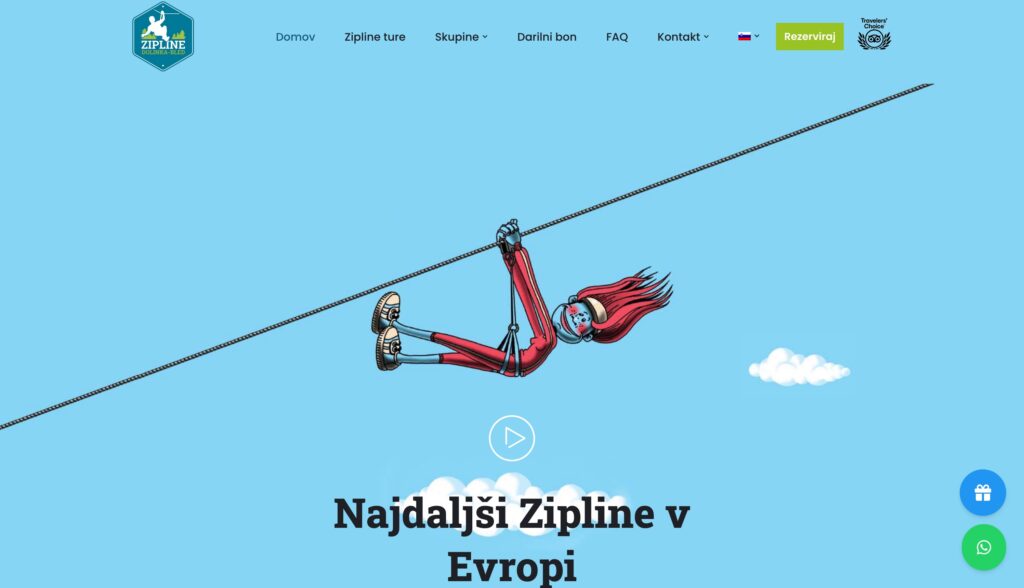
Zipline Dolinka, located in Bled, Slovenia, offers an exhilarating ziplining experience over the Sava Dolinka River and its surrounding protected natural areas. Despite the site’s immersive adventure offerings, the company faced challenges in facilitating easy communication with potential customers, particularly those interested in booking tours or seeking more information.
Challenge:
The primary challenge was the accessibility of the contact information. While the website provided contact details, they were not prominently displayed on every page. Visitors had to navigate through multiple steps to find the contact information, which could lead to potential customers abandoning the site before making inquiries or bookings.
Solution:
To address this issue, Zipline Dolinka implemented a Floating Action Button (FAB) labeled “WhatsApp” on their website. This button was strategically placed to remain visible as users scrolled through the site, ensuring that contact options were always accessible. Upon clicking the FAB, users were presented with a popup contact form, allowing them to submit inquiries directly without navigating away from their current page.
Result:
The introduction of the FAB led to a significant increase in user engagement. Visitors found it easier to reach out with questions or to book tours, leading to a higher conversion rate from site visitors to actual customers. Additionally, the FAB’s constant visibility reinforced the company’s commitment to customer service and responsiveness, enhancing the overall user experience on the website.
By integrating a Floating Action Button, Zipline Dolinka effectively streamlined communication with potential customers, resulting in improved engagement and increased bookings.
2. Case Study: Global Explore Tours – Boosted Newsletter Sign-ups
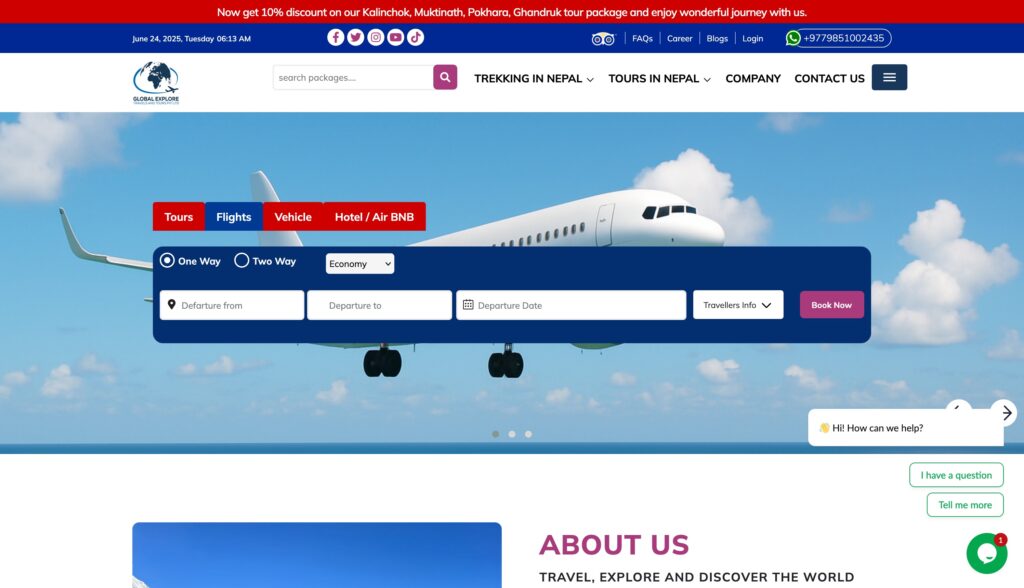
Global Explore Tours, a travel agency specializing in customized luxury tours, wanted to improve customer support and increase direct communication with potential clients. Their existing contact forms and support channels were buried in the website’s navigation, making it difficult for users to quickly reach out with inquiries. As a result, many potential customers left the site without getting the answers they needed, leading to lost opportunities.
Challenge:
The primary challenge was that the agency’s contact options, including the live chat feature, were not easily accessible. Visitors had to navigate through several pages or scroll down to the footer to find the contact form or live chat option, which led to frustrated users who left without engaging further. As a result, Global Explore Tours struggled to provide timely customer support and lost out on converting some interested visitors into clients.
Solution:
To address this, Global Explore Tours implemented a Floating Action Button (FAB) with the text “Chat Now” that was visible on all pages of the website. This button was strategically placed in the bottom-right corner, making it easily accessible to visitors at all times. When clicked, the FAB opened a live chat window, enabling users to immediately interact with a customer support agent or chatbot for real-time assistance. The button was designed in a way that it didn’t interfere with the website content but was prominent enough to catch the user’s attention.
Result:
After launching the live chat FAB, Global Explore Tours saw a 60% increase in customer interactions through the chat feature. Visitors were able to get instant responses to their inquiries, whether they were asking about specific tours, package details, or booking processes. This real-time communication resulted in a 25% increase in bookings, as users were more confident in their decisions after getting quick, personalized responses.
3. Case Study: Sunseekers Resort – Increased Engagement with Contact Form FAB
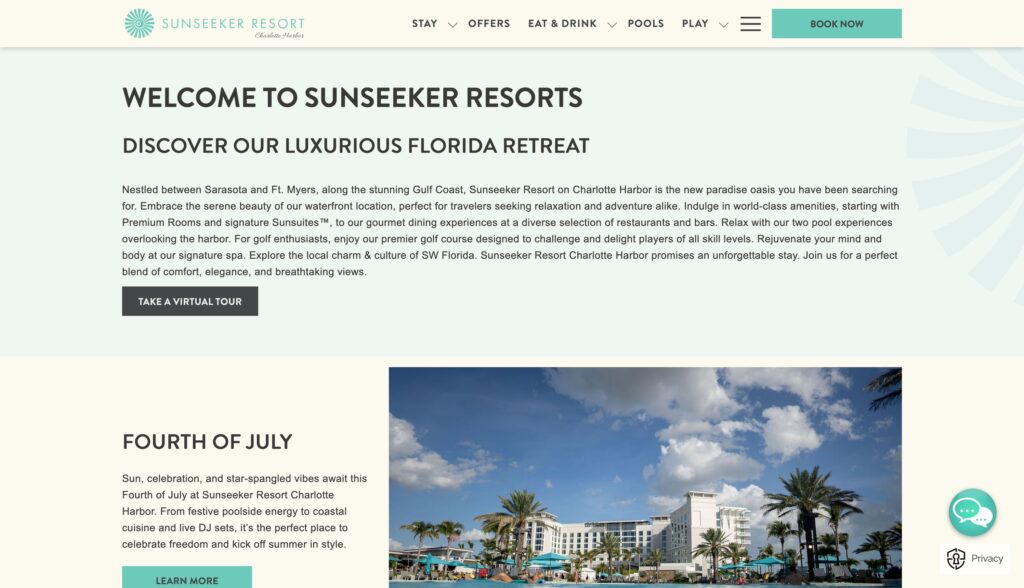
Sunseekers Resort, a luxurious getaway offering a variety of vacation packages and personalized travel experiences, wanted to enhance communication with potential guests and make it easier for them to get real-time assistance. Previously, their contact page was buried in the website’s navigation menu, and users found it challenging to locate or engage with the contact form. This resulted in missed opportunities to assist visitors and convert them into guests.
Challenge:
While Sunseekers Resort had a dedicated contact page, it was not easily accessible or prominently displayed on the website. Visitors had to search through the navigation menu or scroll down to the footer to find the contact details, which led to a frustrating user experience. Consequently, fewer inquiries were submitted, and many potential guests left the site without getting the help they needed.
Solution:
To address this challenge, Sunseekers Resort implemented a Floating Live Chat Button (FAB) with the text “Chat with Us” positioned prominently on the right side of their website. The button was designed to stand out while maintaining a subtle, non-intrusive appearance. When users clicked on the FAB, it immediately triggered a live chat popup, allowing them to engage in real-time conversations with customer service agents for personalized travel advice, inquiries about availability, or booking assistance. The live chat feature was made accessible on both mobile and desktop devices, ensuring a smooth user experience across all platforms.
Result:
The introduction of the floating live chat button delivered immediate and noticeable results. Within the first two weeks, Sunseekers Resort saw a 40% increase in customer interactions through the live chat feature. Visitors were able to ask specific questions about resort packages, room availability, and exclusive offers, leading to higher-quality leads. The live chat also facilitated quicker decision-making, resulting in a 30% increase in bookings as users were able to get the information they needed without delays.
How to Implement a Floating Action Button on Your Travel Website
Here’s a step-by-step guide on how to implement a floating action button on your travel website.
Step 1: Install the FAB Plugin
- Go to your WordPress Dashboard.
- Navigate to Plugins > Add New.
- Search for “Floating Awesome Button.”
- Click Install, then Activate to get started.
Step 2: Create Your FAB Button
- In your dashboard, go to FAB > Add New FAB.
- Search for WhatsApp, Phone or Contact Form from the list of available options.
- Click Add New to add floating button to your website.
Step 3: Customize Your FAB Button
- From the setting, you can change the button text title
- you can change the color, and more
Conclusion
Floating action buttons are a simple yet effective tool for enhancing the user experience on tour and travel websites. By making key actions more accessible, improving navigation, and increasing conversion rates, FABs help your website work harder for you. Whether you want more bookings, more sign-ups, or just a smoother navigation experience, a floating action button can make a significant difference.
For any tour operator or travel business, integrating a FAB is a smart and easy step towards turning casual visitors into loyal customers.


